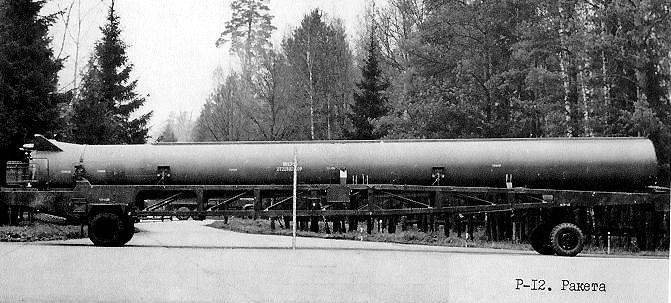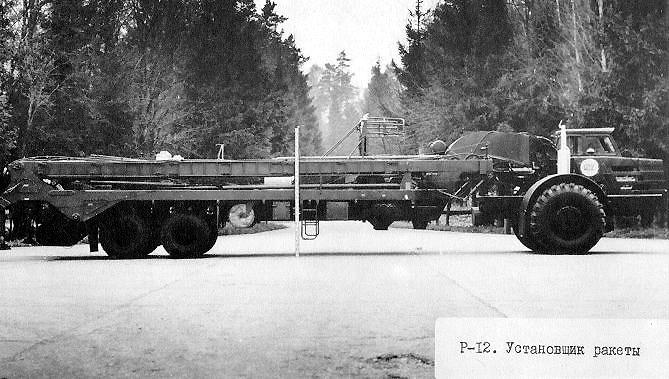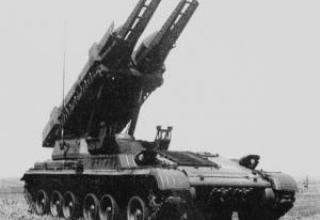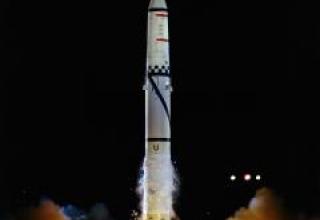According to the Decree of the USSR Council of Ministers dated February 13, 1953 the design department of plant ¹ 586 was assigned to develop a sketch design of medium-range missile R-12 (8K63). August 13, 1955 was issued the Decree of the USSR CM "On the creation and manufacture of missiles R-12". In October 1955 was released a conceptual design. The rocket was designed to hit the surface targets (an area of about 100 km).
In March 1957 at the Research Institute-229 (Zagorsk) were successfully held stand fire tests of the rocket R-12. On June 22, 1957, a new missile was launched from the ground launch table at the GTP № 4 (Kapustin Yar). In October 1958 began mass production of missiles, and December 27, 1958 completed flight tests.
Despite the fact that the R-12 missiles were placed in storage in the arched concrete structures, the launch complex itself due to the abundance of maintenance equipment (which included vehicles, tractors, refuelers, command posts, communication centers, etc.) was a vulnerable target. It was necessary to develop a new method of basing - a mine launcher (MSS). May 30, 1960 the Decree of the USSR Council of Ministers on the development of combat SHPU "Dvina" for the R-12 missile was issued. After a number of improvements (modernization of the control system and removal of aerodynamic stabilizer fairings) December 30, 1961 the first launch of the modernized rocket, designated R-12U (8K63U). Its testing continued until October 1963. The first combat mines for R-12U were built by January 1, 1963 in Plunga (Baltic States), and January 5, 1964 the combat missile system with the rocket R-12U was adopted by the Strategic Missile Forces.
R-12 missile was first demonstrated at the military parade in Moscow in 1961. After the missile system with R-12 was adopted for service, mass construction of military camps and launch positions began. By 1965, 608 launchers for R-12 and R-12U missiles had been deployed. With the appearance of these missiles, the USSR was able to deliver nuclear strikes of operational nature regardless of strategic long-range forces.
In 1962, on the basis of R-12 missiles, the Cosmos (11K63) series launch vehicles were developed.
In the west, the missile was designated SS-4 "Sandal".
By 1987, there were 149 R-12 missiles remaining to be liquidated under the RSMD treaty. The last rocket was destroyed on May 23, 1990 on the basis of liquidation of missile equipment "Lesnaya" in Brest region.
Composition:
The P-12 missile consists of a head unit, a transition compartment, an oxidizer tank, an instrument compartment, a fuel tank and a tail compartment.
R-12 carried a monoblock head end with a 1 Mt thermonuclear charge. The conical head part has a steel riveted construction and asbo-textolite thermal protection coating. The combat compartment takes up 3/4 of the HF volume and has a convex hemispherical bottom at the bottom. The LF is fastened to the missile by means of a short aerodynamic tapered skirt, which is mounted on the transition compartment with its large base and fastened with pyrobolts. The HF section is separated by means of pyrobolts and a pneumatic pusher.
The missile propulsion system consists of a four-chamber RD-214 airborne radar developed by the Design Bureau of Academician V.P. Glushko. The RD-214 engine is mounted in the cylindrical part of the tail compartment with the help of a special frame connected to the traction nodes in the upper part of the combustion chambers. The RD-214 is built according to the open scheme (without afterburning of the exhausted turbogas) as a four-chamber monoblock with a single TNA. Combustion chambers are cylindrical, with flat nozzle heads and profiled nozzles. Cooling of the chambers - combined, flow and curtain. Cooling component - fuel. The engine runs on AK-27I nitric acid oxidizer (27% solution of nitrogen oxides in nitric acid) and TM-185 hydrocarbon combustible. TNA drive - from a turbine rotating gases produced in a gas generator by catalytic decomposition of 80% hydrogen peroxide on silvered copper mesh. Starting the engine is "cannon", without a preliminary stage. Fuel ignition in chambers is chemical, with the help of starting fuel TG-02 (actually it is German "Tonka-250" - amine mixture), poured before refueling the rocket into the fuel main between the TNA and the main valve. The engine traction is regulated before switching off (through the final stage mode) by changing the hydrogen peroxide flow through the gas generator. The traction control system significantly increases the missile's efficiency, as it allows for a flight with optimal acceleration throughout the active section of the trajectory. Prior to shutdown, the engine is switched to the final stage of thrust to obtain a minimum impulse of effect.
The transition compartment, made of aluminum alloys B-95 and D-16, looks like a low ring of riveted construction and consists of a power kit and cladding. Land-based missile oxidizer tank is made of AMg-6 alloy, has a complicated design and consists of two compartments: upper and lower, separated by a common hemispherical bottom. The cylindrical shells of the compartments are smoothly welded, made of rings formed by welding curved sheets with thickening at welding points. The tank is bounded at the top and bottom by hemispherical bottoms connected to the shells by end hoses. The cavity of the upper chamber is connected to the cavity of the lower chamber by means of an overflow pipe reinforced in the central part of the fuel receiving funnel of the oxidizer tank. There is also a fuel overflow valve that switches on the oxidizer supply from the upper part of the tank at the right moment. Such a complex design was first applied in the practice of domestic rocket engineering and was used to improve the missile's alignment when it passes the zone of maximum velocity head. As is known, while the aircraft in flight passes through the sound velocity barrier, its aerodynamic centers are significantly shifted. Added to this is the displacement of the center of mass along the axis of the missile due to the production of fuel from its tanks. This phenomenon was not so noticeable in the first rockets that used liquid oxygen as an oxidizer, but P-12 uses nitric acid, which has a 33% higher density. The change in alignment has a negative effect on the control system: in flight, the control factors have to be changed twice - before and after the sound barrier. To reduce the effects of this phenomenon, an element such as the top compartment of the oxidizer tank has been introduced. When a component is produced from the lower compartment, the change ("drift") of the centre of mass is not so significant, and the control system (CW) may bring it in line with the change in position of the aerodynamic centre before passing through the sound barrier. The overflow valve is then activated and the oxidizer starts to flow into the engine from the top of the tank, thus compensating for the subsequent "drift" of the aerodynamic centre.
The in-bank valves of each compartment consist of longitudinal fluid dampers, fuel level sensors and intake valves. In the upper part of the compartments there are ring inflatable manifolds.
The design of the oxidizer tank of the silo-based R-12U missile was significantly modified. The control system of this version of the missile could already cope with the "drift" of alignment. There was no need to divide the tank into two compartments: it consisted only of a cylindrical shell and two hemispherical bottoms. The fuel tank was basically similar in design to the oxidizer tank of R-12U rocket, but inside it there was an oxidizer flow line in the tunnel pipe. The tanks are inflated with compressed nitrogen during the flight of the missile, the stock of which is concentrated in the battery of cylinders mounted in the tail compartment.
As the wind loads on the missile of the silo-based version are much less than on the R-12, the tank compartment of the former had not such strict requirements on the strength, and therefore it was possible to reduce the thickness of the walls of the tanks and reduce the dry mass of the rocket.
The cylindrical shape instrument compartment of the riveted construction (power kit and cladding) has a cross-shaped frame inside for the installation of pointing and control devices. The SU is autonomous, inheriting many features of a similar A-4 missile system, including gyro devices with significant dimensions. Control signals - analogue, electric, are used for actuation of electric pneumatic and hydrovalves and control mechanisms. Cables and pipelines are laid on the outer side of the tank compartment of the rocket and closed with a chute. The control system provided for an emergency explosion of the rocket.
At carrying out of tests limiting deviations of a point of incidence of MS from calculated on distance within 1100 m, in a direction - about 600 m at firing on the maximum distance in 2000 km have been received. For the first time it included devices for normal and lateral stabilization of the center of mass.
The tail compartment of the riveted structure made of B-95 alloy (power set) and D-16 (cladding) consists of a cylinder and a cone. Inside the cylindrical (upper) part of the compartment is mounted toroidal welded tank with hydrogen peroxide to power the TNA engine. The surface of the tail compartment has hatches for access to the engine units. Conical skirt of the tail compartment is used to transfer the weight of the rocket to the launcher, for which it has four support brackets in the lower part, equipped with screw supports for verticalization of the rocket. Gas steering wheels with steering machines are also mounted on the brackets. Outside the skirt of the ground version of the rocket on the brackets rigidly fixed blades of aerodynamic stabilizers, which are not on the mine version of R-12U.
The R-12 missile was delivered to launch in an undelivered condition. A slightly modified R-5M missile launch table was used for its launch. After the verticalization and aiming by turning the rocket together with the launch table in the right direction, refueling with fuel components and compressed gases began. The total launch preparation time was about three hours and depended on the level of combat calculation training.
Ground equipment of the R-12U rocket was stationary. The level of automation and mechanization of R-12U preparation for launch and its filling was significantly increased.
In the mid-1970s, the missile regiment armed with R-12 missiles consisted of two divisions with ground-based launches and one division with four mine launchers. The ground-launch division consisted of two batteries serving two missiles each, which were stored in concrete caved storage facilities, each for two missiles. Usually the missile regiment had 5-8 ground-based launchers, 11-14 vehicles, 6-7 launchers, 45-52 fuel storage tanks. The distance between the adjacent boosters and the distance from the boosters to the missile storage facilities was more than 175 m.
Characteristics:
| Number of steps | 1 |
| remote control type | WRD |
| Start weight, t | 41.7-42.2 |
| The length of the rocket, m | 22.1-22.77 |
| The diameter of the rocket, m | 1.652 |
| Flight range, km | 2000-2280 |
| Firing accuracy, km | 1.1-2.4 |
| Governing bodies | gas wheels |
| The weight of an empty rocket, t | 3.15 |
| RD-214 engine | Four-chamber |
| Engine weight, kg | 645 |
| Traction on the ground, t | 60 |
| Pressure in combustion chamber, kg/cm2 | 44.5 |
| Fuel weight, t | 37 |
| Weight of combustible TM-185, t. | 7.3 |
| Weight of oxidizer AK-27I, t | 29.065 |
| Control system instrument weight, kg | 430 |
| Weight of a combat unit (light combat unit), kg | 1300-1400 |
| Weight of combat unit (heavy combat unit), kg | 1630 |
Testing:
In October 1962, a rocket with a nuclear charge was launched from Vorkuta on the battlefields on Novaya Zemlya as part of Operation Rosa. In July 1962, a R-12 missile (Operation K-1 and K-2) was launched to investigate the effects of nuclear explosions on missile equipment. October 30, 1962 in the area of the GSP was conducted operation K-5 - explosion of nuclear charge R-12 at an altitude of 60 km to test the possibility of radio communication: communication was not about an hour.
In 1958, according to the program of creation of the national missile defense system, there were started the wiring of ballistic missiles R-2, R-5 and R-12 by the Danube-2 long-range detection station and three RTN in the mode of MRUP (ballistic missile - conventional anti-missile). The first successful intercept of the target - the head part of R-12 missile anti-missile B-1000 with a fragmentation and blast warhead designed by K.I. Kozorezov (with a disk field of defeat at a slow flight of the attacking elements) was carried out March 4, 1961. A total of 11 ballistic missiles of various types were destroyed during the tests, direct hitting of the main units was recorded in two launches of BR-5 and three launches of BR-12. At the final stage of testing the Aldan ABM system in 1976-1977, three launches of A-350J missiles on real targets - missiles 8K63U.
In 1962, the world was on the brink of nuclear war. A crisis erupted as a result of the negative development of the military and political situation in the Caribbean after the Cuban Revolution, which dealt a tangible blow to the economic interests of North American companies. There was a real threat of American intervention in Cuba. Under these circumstances, the USSR decided to provide assistance, including military assistance, to the Cuban Government. Given that the U.S. Jupiter missiles from Turkey could reach the vital centers of the Soviet Union in just 10 minutes, and Soviet ICBMs needed at least 25 minutes to retaliate against U.S. territory, Khrushchev ordered to place Soviet MRBMs with Soviet military personnel in Cuba. According to the plan of operation "Anadyr" it was planned to place three regiments of R-12 missiles on Cuban territory (24 launchers - 3 regiments of the 13th Strategic Missile Division. ) and two regiments of R-14 missiles (16 PU), which were ordered to be ready on a signal from Moscow, to strike the most important objects in the U.S. In conditions of strict secrecy R-12 missiles were delivered to Cuba, where they were built by Soviet military personnel launch pads. American intelligence was unable to detect them in time. Only a month after the arrival on the island of three missile regiments U-2 U.S. air reconnaissance aircraft was able to photograph the launch pads and missiles, which caused great concern at the Pentagon, and then President J. Kennedy. By the end of October, about half of the 36 R-12 missiles delivered to the island were ready for refueling, oxidizing and docking with nuclear warheads. Due to the naval blockade of the Cuban coasts, R-14 missiles did not arrive on the island. It was at that time that leaders of the USSR and the United States came to the conclusion that the conflict should be resolved peacefully. In the course of negotiations the parties agreed to remove the Soviet MRBMs from Cuba, and the American ones - from Turkey and Europe.
Sources:
- Афанасьев И. "Р-12 Сандаловое дерево", приложение к журналу "М-Хобби", вып.9, 1997.
- Карпенко А.В., Уткин А.Ф., Попов А.Д. "Отечественные стратегические ракетные комплексы", г. Санкт-Петербург, 1999.
- http://www.rau-rostov.narod.ru







